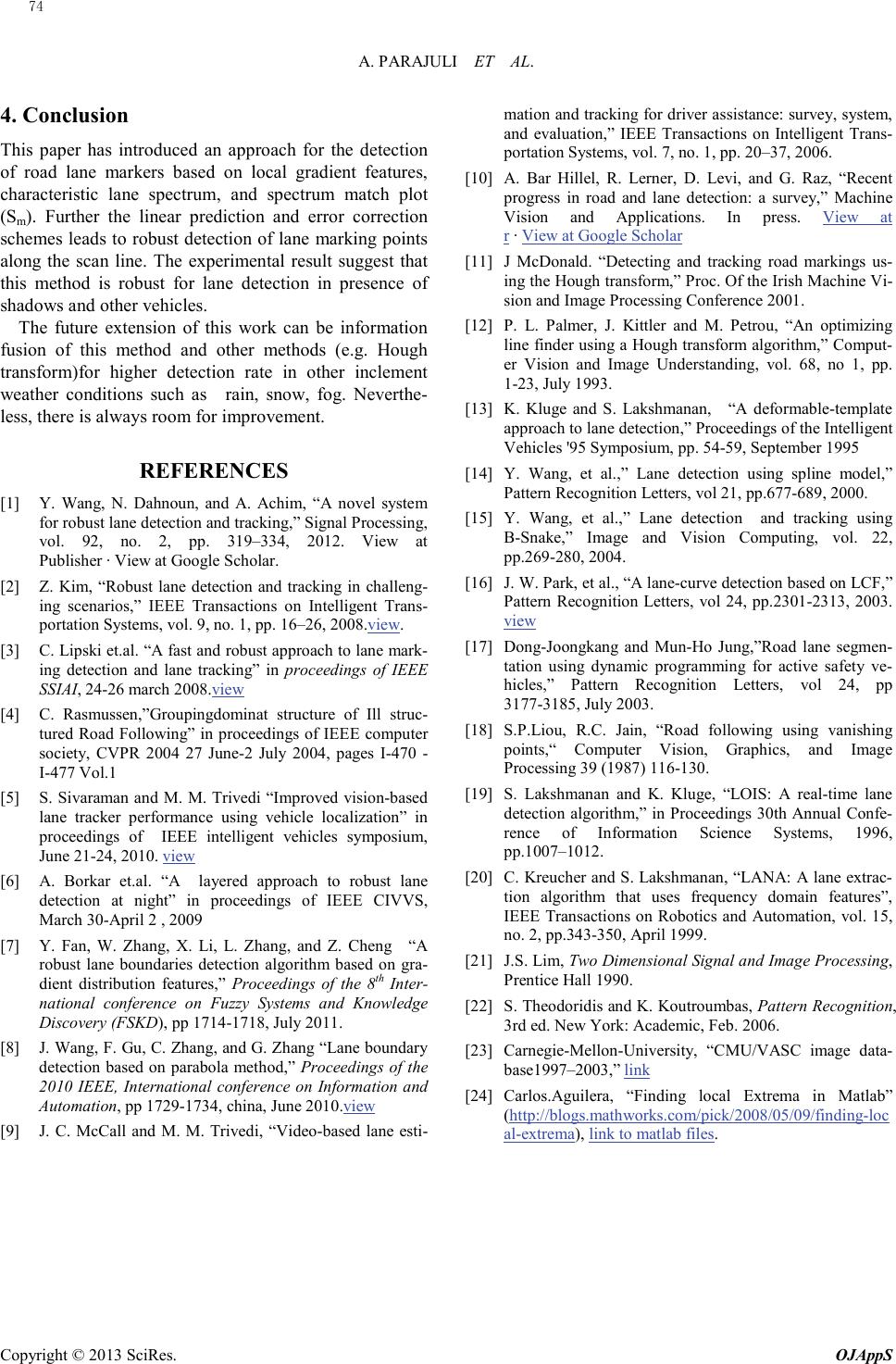
A. PARAJULI ET AL.
Copyright © 2013 SciRes. OJAppS
4. Conclusion
This paper has introduced an approach for the detection
of road lane markers based on local gradient features,
characteristic lane spectrum, and spectrum match plot
(Sm). Further the linear prediction and error correction
schemes leads to robust detection of lane marking points
along the scan line. The experimental result suggest that
this method is robust for lane detection in presence of
shadows and other vehicles.
The future extension of this work can be information
fusion of this method and other methods (e.g. Hough
transform)for higher detection rate in other inclement
weather conditions such as rain, snow, fog. Neverthe-
less, there is always room for improvement.
REFERENCES
[1] Y. Wang, N. Dahnoun, and A. Achim, “A novel system
for robust lane detection and tracking,” Signal Processing,
vol. 92, no. 2, pp. 319–334, 2012. View at
Publisher · View at Google Scholar.
[2] Z. Kim, “Robust lane detection and tracking in challeng-
ing scenarios,” IEEE Transactions on Intelligent Trans-
portation Systems, vol. 9, no. 1, pp. 16–26, 2008.view.
[3] C. Lipski et.al. “A fast and robust approach to lane mark-
ing detection and lane tracking” in proceedings of IEEE
SSIAI, 24-26 march 2008.view
[4] C. Rasmussen,”Groupingdominat structure of Ill struc-
tured Road Following” in proceedings of IEEE computer
society, CVPR 2004 27 June-2 July 2004, pages I-470 -
I-477 Vol.1
[5] S. Sivaraman and M. M. Trivedi “Improved vision-based
lane tracker performance using vehicle localization” in
proceedings of IEEE intelligent vehicles symposium,
June 21-24, 2010. view
[6] A. Borkar et.al. “A layered approach to robust lane
detection at night” in proceedings of IEEE CIVVS,
March 30-April 2 , 2009
[7] Y. Fan, W. Zhang, X. Li, L. Zhang, and Z. Cheng “A
robust lane boundaries detection algorithm based on gra-
dient distribution features,” Proceedings of the 8th Inter-
national conference on Fuzzy Systems and Knowledge
Discovery (FSKD), pp 1714-1718, July 2011.
[8] J. Wang, F. Gu, C. Zhang, and G. Zhang “Lane boundary
detection based on parabola method,” Proceedings of the
2010 IEEE, International conference on Information and
Automation, pp 1729-1734, china, June 2010.view
[9] J. C. McCall and M. M. Trivedi, “Video-based lane esti-
mation and tracking for driver assistance: survey, system,
and evaluation,” IEEE Transactions on Intelligent Trans-
portation Systems, vol. 7, no. 1, pp. 20–37, 2006.
[10] A. Bar Hillel, R. Lerner, D. Levi, and G. Raz, “Recent
progress in road and lane detection: a survey,” Machine
Vision and Applications. In press. View at
r · View at Google Scholar
[11] J McDonald. “Detecting and tracking road markings us-
ing the Hough transform,” Proc. Of the Irish Machine Vi-
sion and Image Processing Conference 2001.
[12] P. L. Palmer, J. Kittler and M. Petrou, “An optimizing
line finder using a Hough transform algorithm,” Comput-
er Vision and Image Understanding, vol. 68, no 1, pp.
1-23, July 1993.
[13] K. Kluge and S. Lakshmanan, “A deformable-template
approach to lane detection,” Proceedings of the Intelligent
Vehicles '95 Symposium, pp. 54-59, September 1995
[14] Y. Wang, et al.,” Lane detection using spline model,”
Pattern Recognition Letters, vol 21, pp.677-689, 2000.
[15] Y. Wang, et al.,” Lane detection and tracking using
B-Snake,” Image and Vision Computing, vol. 22,
pp.269-280, 2004.
[16] J. W. Park, et al., “A lane-curve detection based on LCF,”
Pattern Recognition Letters, vol 24, pp.2301-2313, 2003.
view
[17] Dong-Joongkang and Mun-Ho Jung,”Road lane segmen-
tation using dynamic programming for active safety ve-
hicles,” Pattern Recognition Letters, vol 24, pp
3177-3185, July 2003.
[18] S.P.Liou, R.C. Jain, “Road following using vanishing
points,“ Computer Vision, Graphics, and Image
Processing 39 (1987) 116-130.
[19] S. Lakshmanan and K. Kluge, “LOIS: A real-time lane
detection algorithm,” in Proceedings 30th Annual Confe-
rence of Information Science Systems, 1996,
pp.1007–1012.
[20] C. Kreucher and S. Lakshmanan, “LANA: A lane extrac-
tion algorithm that uses frequency domain features”,
IEEE Transactions on Robotics and Automation, vol. 15,
no. 2, pp.343-350, April 1999.
[21] J.S. Lim, Two Dimensional Signal and Image Processing,
Prentice Hall 1990.
[22] S. Theodoridis and K. Koutroumbas, Pattern Recognition,
3rd ed. New York: Academic, Feb. 2006.
[23] Carnegie-Mellon-University, “CMU/VASC image data-
base1997–2003,” link
[24] Carlos.Aguilera, “Finding local Extrema in Matlab”
(http://blogs.mathworks.com/pick/2008/05/09/finding-loc
al-extrema), link to matlab files.